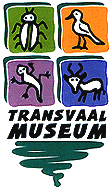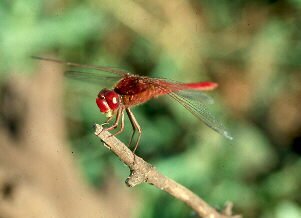
E - MAIL
Collection manager (Invertebrates)
Albert Makubung
Preparator
LINKS
Visit the site dedicated
to the locally infamous
Entomology Links
Department of Invertebrates
General Enthomology Collection
Order ODONATA (Dragonflies & Damselflies)
Dragonflies are large, strong flying, brightly colored insects that belong to the order Odonata. They are found world-wide except for in extremely cold regions such as Antarctica, northern Canada and Asia, and Iceland. There are about 5,000 species of odonates.
There are three sub-orders in the Odonata:
- Anisoptera (Dragonflies) whose hind and fore wings are a different shape. They rest with their wings held out.
- Zygoptera or "damselflies", who are small and delicate and with both the fore- and hind wings being the same size and rest with they wings folded in.
- Anisozygoptera, which resemble the Anisoptera, but share similar characteristics between both the Zygoptera and Anisoptera sub-orders.

Suborder Anisoptera
MORPHOLOGY
The Head: The head consists of six segments that contain different structures:- First segment -compound eyes
- Second segment -antennae (consists of three to seven joints)
- Third segment-none
- Fourth segment-mandibles (teeth are extremely strong)
- Fifth segment- first maxillae (jointed appendages not as strong as those of the mandible)
- Sixth segment-second maxillae
The Thorax: The thorax of the dragonfly is highly specialized to meet the requirements of supporting powerful wings and the altered functions of the legs. There are three pairs of legs, one connected to each thoracic segment. Though the legs are short, they are of considerable strength and are covered with tiny spines.
The Abdomen: The abdomen of the dragonfly consists of ten segments. At the far of the abdomen is a set of anal appendages. The shape of the abdomen shape is always narrow and elongated.
LIFE CYCLE OF ODONATA
All Odonata share a common life cycle. First, eggs are laid in or near fresh water, depending on if the female possesses a complete ovipositor (if a female has a complete ovipositor, she is able to submerge herself and lay her eggs in plant tissues or decayed wood). In the following spring, the eggs hatch. The larvae pass through 11-12 larval stages. Almost always, the larvae are aquatic and prey on other small insects, fish or tadpoles. The larvae capture prey by means of hooks on their lower lip (labium), which is rapidly released to strike their prey.Larval lives can last anywhere from several months to several years. In the last stage of development, several signs of metamorphosis occur:
- wing-cases swell to accommodate the developing adult wings
- the pigmented area increases as a result of developing eyes
- tissue retracts from the long larval labium to build the short labium of the adult
During the pre-reproductive adult phase, the dragonflies are maturing sexually. This period could last anywhere from a few days to several weeks. At this time, the freshly emerged dragonflies leave the emergence site and begin to feed. Another change that occurs over this period is in body color. A distinct difference in color may develop between the two sexes, the male often appearing more colorful.
Not only do dragonflies mature during this period, they also disperse. Some stay close to the emergence site, while others may fly extreme distances in flocks. The two primary needs for dispersal are overpopulation and habitat requirements that differ from those of the larva.
The reproductive period begins when the adults show reproductive behavior. This is usually signified by a return to fresh waters similar to the ones from which they came. Males return first, followed by the females, who have developed a batch of eggs. When the two sexes meet, and if the female is receptive, they immediately begin mating. After the eggs are laid, both the male and the female leave the site and don't return until another batch of eggs have developed.